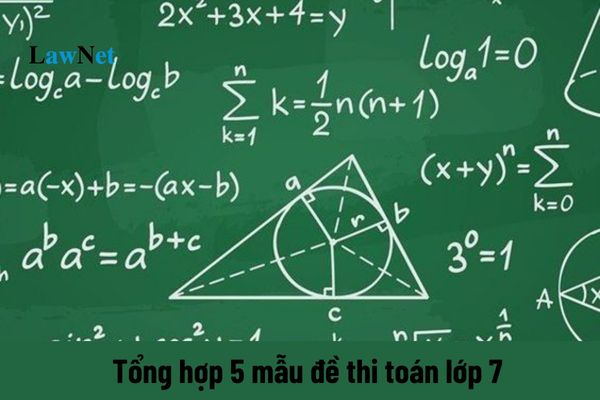Vietnam: What are the 05 sample question papers of 7th-grade Mathematics? What are the characteristics of Mathematics?
What are the 05 sample question papers of 7th-grade Mathematics in Vietnam?
The 1st mid-semester question papers of 7th-grade Mathematics have been carefully selected and are available for reference:
1st mid-semester question papers of 7th-grade Mathematics...download
1st mid-semester question papers of 7th-grade Mathematics...download
1st mid-semester question papers of 7th-grade Mathematics...download
1st mid-semester question papers of 7th-grade Mathematics...download
1st mid-semester question papers of 7th-grade Mathematics...download
Note: Content is for reference purposes only!

What are the 05 sample question papers of 7th-grade Mathematics? What are the characteristics of Mathematics? (Image from the Internet)
What are the characteristics of Mathematics in Vietnam?
According to the Lower Secondary Education Program in Mathematics promulgated with Circular 32/2018/TT-BGDDT, the specific regulations are as follows:
Mathematics increasingly finds applications in life, and the basic mathematical knowledge and skills have helped people solve real-life problems systematically and accurately, thereby contributing to societal development.
Mathematics in schools plays a part in forming and developing essential qualities, general competencies, and mathematical competencies for students; developing key knowledge and skills, and creating opportunities for students to experience and apply mathematics in real life; establishing connections between mathematical ideas, between mathematics and real life, and between mathematics and other educational activities, particularly with subjects like Science, Natural Sciences, Physics, Chemistry, Biology, Technology, and Informatics to implement STEM education.
The content of mathematics tends to be logical, abstract, and general. Hence, to understand and learn mathematics, the school mathematics program must ensure a balance between "learning" knowledge and "applying" that knowledge to solve specific problems.
During the process of learning and applying mathematics, students always have the opportunity to use technological means, and modern teaching equipment, especially electronic calculators and handheld calculators, to support expression, exploration, and the solving of mathematical problems.
In the general education program, Mathematics is a compulsory subject from grade 1 to grade 12. The mathematics educational content is divided into two phases:
- Basic Education Phase: Mathematics helps students understand systematically the essential mathematical concepts, principles, and rules necessary for everyone, providing a foundation for further academic pursuits or daily life use.
- Career Orientation Education Phase: Mathematics provides students with a relatively comprehensive view of mathematics, understanding its role and applications in reality, and the mathematics-related professions, enabling students to orient their careers and to independently explore mathematical issues throughout their lives. In addition to core educational content, each academic year, students (especially those oriented toward natural sciences and technology) can select from various study modules. These modules aim to enhance knowledge about mathematics, and skills to apply mathematical knowledge in practice, meeting the interests, needs, and career orientations of students.
The mathematics curriculum in both educational phases has a linear structure combined with a "concentric spiral" approach (concentric, expanding, and elevating) revolving around and integrating three knowledge strands: Numbers, Algebra and Some Elements of Calculus; Geometry and Measurement; Statistics and Probability.
What are the objectives of the Lower Secondary Education Program in Mathematics in Vietnam?
According to the Lower Secondary Education Program in Mathematics promulgated with Circular 32/2018/TT-BGDDT, the specific regulations are as follows:
The Lower Secondary Education Program in Mathematics aims to help students achieve the following primary objectives:
+ Contribute to forming and developing mathematical competence with required achievements: posing and answering questions when reasoning, solving problems, performing reasonable reasoning when solving problems, proving not overly complex mathematical propositions; using mathematical models (mathematical formulas, algebraic equations, representations, etc.) to describe situations arising in some not overly complex real-life problems; using mathematical language combined with ordinary language to express mathematical content as well as exhibit evidence, methods, and reasoning results; presenting ideas and the use of tools and means to perform a learning task or to describe mathematical reasoning and proofs.
+ Possess basic mathematical knowledge and skills about:
++ Numbers and Algebra: Number systems (from natural numbers to real numbers); calculations and computational tools; algebraic language and notation; transforming algebraic expressions, equations, systems of equations, inequations; using function language to describe (model) some processes and phenomena in real life.
++ Geometry and Measurement: The content of Geometry and Measurement at this level includes Intuitive Geometry and Plane Geometry. Intuitive Geometry continues to provide language, notation, and descriptions (at an intuitive level) of real-world objects (plane figures, solids); establish common geometric models; compute some geometric elements; develop spatial imagination; solve some simple real-world problems related to Geometry and Measurement. Plane Geometry provides knowledge and skills (at a logical reasoning level) regarding geometric relations and some common plane figures (points, lines, rays, segments, angles, parallel lines, triangles, quadrilaterals, circles).
++ Statistics and Probability: Collect, classify, represent, analyze, and process statistical data; analyze statistical data through frequency and relative frequency; recognize some simple statistical laws in reality; use statistics to understand basic concepts about experimental probabilities of events and probabilities of events; recognize the significance of probability in real life.
+ Help students gain initial awareness of careers related to mathematics; cultivate vocational orientation based on ability and interest, condition, and circumstances of themselves; guide post-secondary educational directions (continue further education, vocational training, or enter into labor life).

